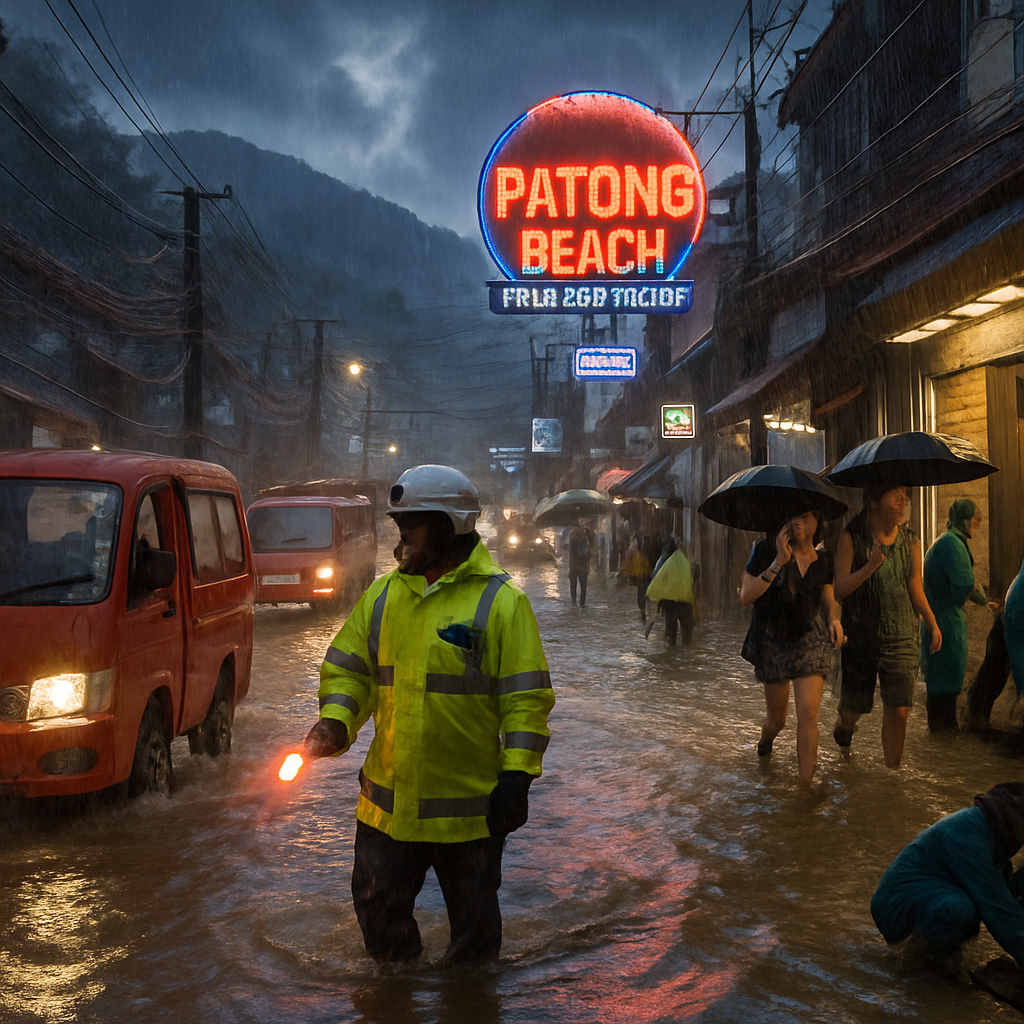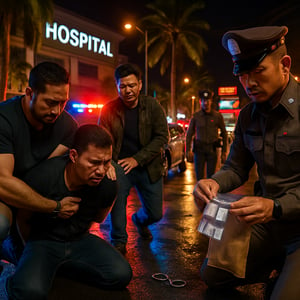Patong found itself ankle-deep (and in some places worse) in the kind of dramatic downpour that turns a sunny tourist strip into a makeshift canal. On November 18 at about 4:30pm, sudden heavy rain sent waterways and roads into chaos, prompting Patong Police to issue urgent warnings and dispatch officers to manage traffic and monitor rising water levels.
Police move fast as streets become rivers
The response was led by Patong Police Superintendent Police Colonel Chalermchai Hirasawat, with traffic and investigative teams coordinated by Police Lieutenant Colonel Somporn Surin and Pol. Lt. Col. Chamnan Trapsin. In a statement released after the deluge, officials told motorists to avoid several waterlogged zones where smaller vehicles simply could not get through.
Hotspots and road closures
Officers confirmed multiple trouble spots across the tourist hotspot, describing several areas as “awaiting drainage.” The worst-affected locations included:
- Patong Hospital Intersection: closed to small vehicles
- Nanai Soi 8: closed to small vehicles
- Pearl Roundabout: closed for traffic heading towards Coconut Intersection
- Sai Nam Yen Intersection: blocked for vehicles heading past Patong Hospital
- Fire Station Intersection: impassable
- Arunphat Village, Nanai Road: flooding awaiting drainage
- Loma Intersection: minor flooding but still passable
As traffic cameras and officers on the ground reported, the usual hum of tuk-tuks and scooters was replaced by cautious horn-honking and long queues as drivers deliberated whether to brave watery streets or detour through back lanes.
What caused it — and how long will it last?
Police attributed the disruption to intense rainfall combined with rapid runoff from the surrounding hills. That steep topography funnels water down toward Patong’s busy center, and when the rain arrives in force, drainage systems can struggle to keep pace.
Authorities said the floodwaters were expected to subside within an hour if the rain eased, but warned that congestion and delays would likely persist as traffic slowly returned to normal.
Warnings from Patong Municipality and safety reminders
Patong Municipality echoed the police warnings, advising residents and visitors to avoid flood-prone zones and exercise extra caution near hillsides where sudden runoff could create dangerous surges. Officials also urged homeowners and shopkeepers to check electrical appliances and wiring if water had entered premises — a critical reminder that flood damage can be both costly and hazardous.
For those in immediate need of assistance, the Disaster Prevention and Mitigation Office can be reached at 076-342600.
Context: a month of warnings
This incident follows broader warnings earlier in the month when Phuket officials urged residents to brace for flash floods, heavy rain, and strong winds as a powerful monsoon system soaked the island. Phuket Governor Saransak Srikruanetra had flagged intensified southwesterly monsoon winds as a driver of extreme weather along the Andaman coast — a seasonal pattern locals know all too well.
Practical tips if you’re in Patong when the rain hits
- Avoid driving through floodwater. Depth is hard to judge and even knee-high water can stall small vehicles or sweep them away.
- If water enters your home or shop, switch off electricity at the breaker only if you can do so safely from dry ground.
- Move valuables and important documents to higher shelves; keep a flashlight and dry clothes accessible.
- Follow local authority updates — police and municipal channels will have the latest road closures and safety advice.
- Consider delaying travel during peak downpours; time spent waiting it out in a safe spot will usually be shorter and less stressful than dealing with stalled cars or flooded engines.
Tourists, locals and business owners — what to expect next
For business owners on Nanai Road and nearby lanes, a pause in trade can be expensive, but most will be back in business once drainage crews finish their work and the water recedes. Tourists are advised to check their hotel notices and local news for updates before heading out to beaches or excursions. Locals who live uphill should also be mindful of sudden runoff and wear sturdy footwear if they must move through wet, slippery terrain.
Patong’s dramatic downpour is a reminder that even familiar places can change quickly when the monsoon flexes its muscles. With an active police presence and coordinated municipal alerts, residents and visitors can stay safer by heeding warnings and taking simple precautions. Keep emergency numbers close (076-342600 for the Disaster Prevention and Mitigation Office), stay tuned to official channels, and wait for the green light before venturing back onto the roads.


















This is ridiculous — Patong floods every rainy season and nothing lasting gets fixed. Tourists will freak out but locals keep paying the price for bad planning.
People travel to a beach town, they should expect rain sometimes. Why blame the city all the time?
Police acted fast and warned people; that matters. But yes, better infrastructure would reduce the chaos.
Quick warnings help, but sirens and cones don’t stop a shop from losing a day’s takings or a motorbike from drowning. We need real drainage investments, not just PR.
As someone who lives uphill, runoff is terrifying — whole lanes become rivers in minutes. The drains are clogged half the time and the municipality only reacts after the water’s already inside houses.
Intense rainfall events are increasing with climate change, and steep topography in places like Patong amplifies flash flooding. Urban design must incorporate runoff retention and green infrastructure.
Exactly — permeable pavements and retention basins would help, but retrofitting is costly and needs political will.
Thanks for the explanation. The science is clear but where does funding come from when tourism dips after every storm?
My shop on Nanai lost customers all afternoon while drains did nothing. These one-hour ‘we’ll be fine’ estimates are optimistic and hurt small businesses.
Small businesses should have contingency plans. You can’t expect the whole town to stop because of rain.
Contingency plans are fine, but recurring infrastructure failure is a systemic issue, not poor planning on individual owners.
Plans are good until the stock is ruined and the hotel guests get stranded. It’s easy to lecture when you don’t rely on daily cash.
Visited Patong last year and saw drains bubbling — I nearly missed my flight because of floods like this. Tourists need clearer advisories before they book.
Maybe tourists should check weather patterns instead of expecting perfect postcards. Monsoon season exists for a reason.
Sure, but travel companies and hotels could be more proactive about cancellations and rerouting during peak storms.
This event highlights the intersection of climate volatility and urban vulnerability. Adaptive planning, early warning systems, and budget reallocation toward resilient infrastructure are non-negotiable.
Agreed — zoning laws near steep runoff areas and mandatory elevation rules for storefronts could reduce damages, but enforcement is the hurdle.
Enforcement means costs to property owners. Without subsidies or incentives most will resist changes that cut profit.
Incentives plus phased regulations work. If the government ties tourism licensing to resilience measures, private actors will follow.
Wow, streets turned into rivers? That looks like in video games. Are people okay?
Yes, most people were warned and there were police on the scene. But it’s a good time to learn about safety: never drive through floodwater and follow official instructions.
Thanks! I’ll tell my mom to be careful if we ever go there.
I don’t buy that this is mainly climate change — it’s decades of ignoring simple drainage maintenance. People like to blame big trends instead of local negligence.
Both can be true. Neglect worsens climate impacts. Pointing fingers at one or the other stops us from fixing both problems.
Fine, fix both then. But stop using climate as an excuse to delay actual municipal responsibility.
Blaming is easy. Funding and skilled labor to rebuild drainage is the hard part — and that’s political will, not conspiracy.
Shop owner here — the advice to turn off electricity is important but risky if power boxes are wet. How do we get guaranteed emergency help when water comes in?
We advise residents to call the Disaster Prevention office for immediate assistance. We are coordinating cleanup crews and monitoring key intersections.
Official assistance is good, but response time matters. Locals need training and affordable protective gear to reduce immediate hazards.
Why do motorbike drivers even try to cross deep water? It feels like reckless risk-taking that endangers everyone.
Many riders are earning per-ride income and can’t afford to wait; it’s not always recklessness — it’s survival for some families.
I didn’t think of that. Still, maybe better enforcement of road closures could protect both riders and drivers.
Maybe tourists should just avoid Patong during monsoon months. Let locals fix the place without outsiders complaining about canceled plans.
Tourism is our main income; telling tourists to stay away is like telling us to close shop. We need smart schedules, not boycotts.
I get that, but irresponsible tourism at the wrong time strains local services. Balance is needed.
This follows earlier warnings this month; the intensifying monsoon pattern is affecting the whole Andaman coast. Local authorities had alerts but the hits still land hard.
Historically Patong adapted with raised walkways and canals; modern concrete development disrupted those systems. We might need to relearn old, localized solutions.
Good point — combining traditional water management with modern tech might be the most cost-effective path forward.
Police names were in the article — officers deserve credit for coordinating traffic and warnings under pressure. The human effort shouldn’t be lost in the debate.
Acknowledging frontline workers is fair, but systemic accountability for long-term solutions is still necessary.
Absolutely — praise for responders doesn’t excuse policymakers from planning.